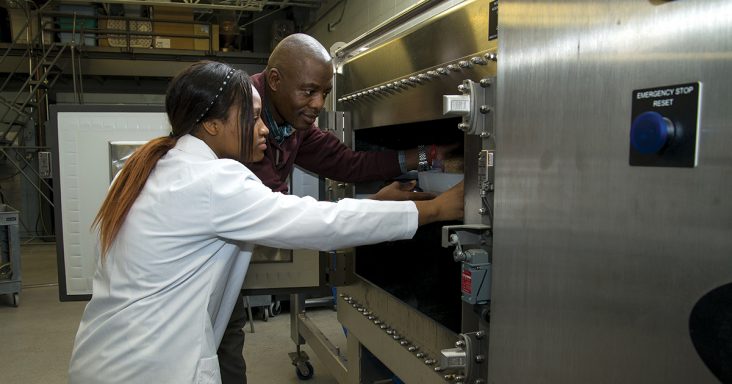Microwave process could improve rice yield, add millions in profits
by December 12, 2020 7:11 am 607 views

Microwave technology may offer a faster drying system for rice than conventional heated-air drying systems and could significantly increase profitability, said Griffiths Atungulu, associate professor of food processing and post-harvest system engineering for the University of Arkansas System Division of Agriculture.
Atungulu is co-principal investigator with AMTek Microwaves, a Cedar Rapids, Iowa, based company. It has received a $100,000 Small Business Innovation Research grant from the U.S. Department of Agriculture’s National Institute of Food and Agriculture to study microwave drying methods.
Rough rice is ideally reaped at a harvest moisture content of up to 21%, Atungulu said. Before milling, processors must reduce the moisture content to a target of about 12.5%.
Conventional rice drying systems use natural air in-bin or crossflow column dryers. In-bin drying can require many days to dry rice. Rice processors commonly use crossflow column dryers, which direct heated air across a column through which rough rice falls. Dryers can speed up the process but still take considerable time, Atungulu said.
Crossflow column dryers usually require multiple passes of the rice through the column separated by tempering periods, which maintain the rice at a warm temperature. It commonly takes about three passes through the crossflow dryer to reduce the rice to 12.5% moisture content.
Tempering often takes place overnight with the drying process often requiring two days or more to complete, Atungulu said.
It also impacts head rice yield, the percentage of kernels that are at least three-quarters of their original length after milling, he said. The extended exposure to heated air can cause fissures in rice kernels’ physical structure, making them brittle. Milling the rice then results in breaking some of the fissured kernels, reducing the head rice yield. Other factors, including environmental conditions and rice genetics, contribute to head rice yield. U.S. head rice yield averages are 55% to 58% of the total rice volume.
“The yield could be lower, depending on prevailing environmental conditions during harvest,” Atungulu said.
Using a microwave dryer about the size of a commercial restaurant oven, Atungulu has developed a method of drying rice to the target moisture content of 12.5% in a single pass under laboratory conditions, he said.
His goal was to develop a one-pass drying method that maintained head rice yield at or above the national average. He looked for a microwave drying method that did not adversely affect rice color or flavor or increase rancidity, which can occur in the bran layer.
“We didn’t want to change anything that would affect consumer acceptance of rice products,” he said.
In years of preliminary research, collaborating with AMTek and several rice processing companies, Atungulu showed that a microwave frequency of 915 Megahertz — most home microwaves operate at a maximum of 2.45 MHz — could dry rice in a single pass with less impact on head rice yield. It also met the requirement of not affecting consumer-desired color or flavor.
In the proof of concept, Atungulu has two goals.
“First, we have to satisfy the rice processors,” he said. “We want to demonstrate that microwave drying reduces the time required for drying rice while reducing fissuring to improve head rice yield.”
Atungulu’s target is to improve the national average of 55-58% head rice yield to at least 65%.
“That would translate to a $145 million increase in rice value annually,” he said.
Also, a microwave drying system requires a smaller machinery footprint, thus saving space, Atungulu said.
“Second, we have to satisfy consumers. That means we have to preserve flavor, texture, color and cooking quality.”
During the industry-scale research, Atungulu will work on optimizing the system to meet those industry and consumer requirements. His research so far has identified 915 MHz as an efficient frequency to meet his goals. But on a large scale, Atungulu said, that may not be the ideal frequency for all rice varieties.
“Some frequencies may not penetrate fully into some varieties. We may also have to adjust how the microwave energy is delivered. Perhaps some components will have to be designed to control how the energy diffuses into the rice. These are the things we’ll have to play around with to find the optimal design and control for commercial microwave rice drying,” Atungulu said.
Existing multiple-pass crossflow column dryers may be less efficient than microwaves, but Atungulu says they have a proven track record. They are also durable, continuing to work for decades with regular upkeep. Rice processors will not be easily convinced to convert their drying systems. An essential goal of the proof-of-concept stage of his research, Atungulu said, is to demonstrate with conclusive data the economic benefits of microwave rice drying.
“We understand the feasibility of microwave drying,” Atungulu said. “We also want to be able to articulate the merits of the system.”
Even with convincing data, Atungulu expects conversion will not happen overnight but will more likely happen in stages. Given the durability of existing rice dryers that may take considerable time.
Rice growers were projected to plant about 1.39 million acres of rice in 2020. The acreage is a rebound from 2019’s 1.15 million acres, but still shy of 2018’s 1.44 million acres. The modest increase surprised some analysts who expected acreage as high as 1.5 million acres, given prevailing market conditions.
Rice has a significant impact on the state’s economy, according to the Arkansas Farm Bureau. The crop is the most exported from the state and is its second most valuable. The rice industry has a more than $4 billion impact on the state’s economy and 25,000 jobs are rice dependent.
